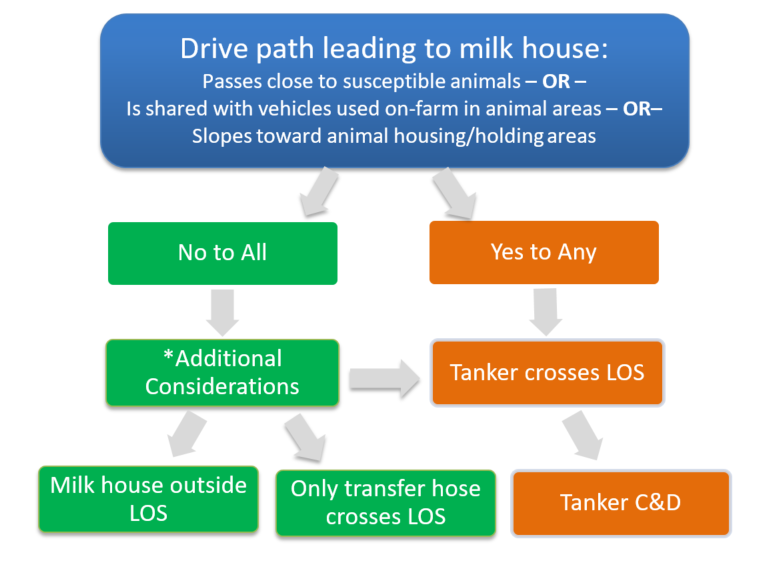- Cleaning and disinfecting (C&D) a milk truck/tanker may prove difficult in certain climates and weather situations and is resource intense (water, disinfectant, personnel time, protective gear, etc.).
- Some dairy premises, based on their layout, will need to C&D the truck/tanker to allow entry.
- Others may have a layout that allows the truck/tanker to remain outside the LOS during milk collection.
The decision tree below and subsequent checklist can be used to determine which approach is best for each operation.
Determining if the Milk Truck/Tanker Needs to Cross the LOS and be C&D

The first step in choosing the best LOS option is to determine whether the milk truck needs to cross the LOS and be cleaned and disinfected. If the drive path leading to the milk house passes close to susceptible animals, OR is shared with other vehicles used on-farm in animal areas, OR slopes toward animal housing/holding areas, then the tanker must cross the LOS and be C&D’d. If none of those is true about the milk drive path, then there are additional considerations to determine whether the milk house can be outside the LOS during milk collection or only the transfer hose crosses the LOS. These additional considerations are addressed below.
Additional Considerations
The questions below help further determine which LOS option best suits your dairy premises.
-
Doors leading from the milk house can be established as controlled access points with signage, proper biosecurity steps posted, and all supplies required to meet the biosecurity steps.
If YES, the milk truck/tanker MILK HOUSE OUTSIDE THE LOS is an option for your dairy premises. See Summary of LOS Options below and LOS Options for milk collection for more information.
If NO, proceed to questions 2-4.
-
State requirements for a licensed weigher/sampler to perform milk collection duties can be met
-
Transfer hose is available that is long enough to reach from the bulk tank to the milk tanker through a controlled access point and does not exceed pump manufacturer’s recommendations.
-
Hauler/driver can work with farm personnel to accomplish milk collection activities.
If YES to questions 2-4, then ONLY TRANSFER HOSE CROSSES LOS is an option for your dairy premises. See Summary of LOS Options below and LOS Options for milk collection for more information.
If NO to ANY of the above, MILK TRUCK/TANKER AND HAULER/DRIVER CROSS LOS is the only option for your dairy premises, and the truck/tanker must be C&D. See Summary of LOS Options below and LOS Options for milk collection for more information.
Summary of LOS options
Milk House Outside LOS
- Tanker, hauler, and transfer hose do not cross the LOS (i.e., the milk house is “outside” of the LOS)
- Hauler/driver transporting direct load tankers, transport tankers, or commingled loads
- Hauler enters the milk house to pump milk
- No C&D of truck/tanker required
Only Transfer Hose Crosses LOS
- Truck/tanker and hauler/driver do not cross the LOS
- Hauler/driver transporting direct load tankers, transport tankers, or commingled loads
- Farm staff handles the transfer hose on the milk house side of the LOS
- Licensed milk hauler on staff
- Transfer hose undergoes exterior C&D
- No C&D of truck/tanker required
Milk Truck/Tanker and Hauler/Driver Cross LOS
- Hauler/Driver follows proper biosecurity protocols on exiting truck cab
- C&D of truck/tanker required
- Hauler/driver transporting direct load tankers, transport tankers, or commingled loads
- Truck/Tanker and hauler/driver cross the LOS Access Point onto the farm-side of the LOS to collect milk

